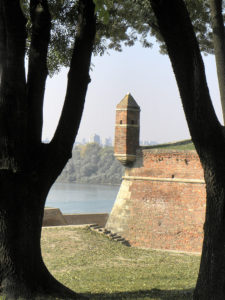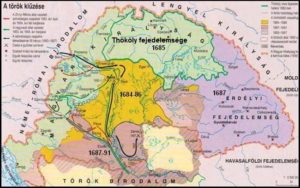
Nándorfehérvár / Belgrade

The castle of Nándorfehérvár aka Belgrade (Griechisch Weissenburg), the capital of Serbia. It is situated at the confluence of the river Danube and Száva rivers and its castle was built 51 meters above their level on a hilltop. In a nutshell, I have to tell you about the full history of the town because it is most interesting due to its special location.

The history before the Hungarians’ conquest
It was Herodotus who first mentioned the city and he said its inhabitants were Scythians. The Celts appeared there in the 4th century B.C. and named the place Singidunum. The Romans took this name over 300 years later. The city became part of the Eastern Roman Empire in 395 A.D. and it was called Alba Graeca. It was the northern bastion of the Byzantine Empire but the Huns of Attila destroyed it in 449 A.D. then it was taken by the Sarmatians.
It was Theoderic the Great who took it back for Byzantium but the ancient Singidunum was destroyed in the 7th century by the Avar and Slavic attacks. The town came under Bulgarian rule in the 9th century and was called Alba Bulgarorum. Emperor Basileus II attached it to his Eastern Roman Empire in 1018 and the place became the target of the Hungarian-Byzantine contest.
The Hungarian rule
It was the Hungarian King Salamon who first took the castle for Hungary in 1071 when he was leading a campaign against the intruding Pecheneg (Besenyő) tribes who were burning the Szerémség (Sirmium) of Hungary, paid by Byzantium. The two brothers of King Salamon had also taken part in its siege, Géza, and László. The defenders of Alba Graeca used Greek fire against them and they were fighting for a long time but there was a captured Hungarian girl in their castle who put the fort on fire and the defenders had to surrender not much later. However, the Byzantine Empire took the castle back the next year and the troops of King István II could regain it only in 1127.
The Hungarians pulled the fort down and built up the castle of Zimony from its stones. In answer to this, Emperor Manuel had Zimony ruined down and had Nándorfehérvár built up again. King Béla III was the one who finally took and ruined the castle at the same time, in 1183.

Hungary’s main rival became the Bulgarian Kingdom which took Belgrade in 1230 but King Béla IV took the fort back from King Aszen II in 1232. Nándorfehérvár (in Hungarian, it means: „the white castle of the Bulgarians”) became the center of the Hungarian Macsó County in 1267. It is interesting but I must remark that there are two important cities in Hungary with similar names: the old capital of the kingdom, Székesfehérvár, and the capital of Transylvania, Gyulafehérvár.

Serbians and Hungarians…
The city went to Serbia first with marriage when the Serbian King Dragutin wed the Hungarian Princess Katalin. Yet, the city had to be returned to Hungary in 1319. Belgrade was ruled by the Serbian Czar Dusan between 1334-1355 and next time it was in Serbian possession again between 1403-1427. It was the time when King Zsigmond of Hungary gave it to the Serbian ruler, Stefan Lazarevic, along with the County of Macsó. King Zsigmond had had the castle totally rebuilt previously.

According to a treaty, the castle and the county had been given back to the Hungarian king in 1427. The castle was given into the care of the Tallóci family until the first Ottoman siege of 1440. Sultan Murad II tried to take the fort but the Provost of Vrána, Tallóci János, was defending the castle heroically for months. After the siege, King Ulászló I nominated Hunyadi János (John Hunyadi) and Újlaki Miklós as captains of Nándorfehérvár.
The great siege of the castle took place in 1456. The taker of Constantinople, Sultan Mehmed II wanted to take Nándorfehérvár with his huge army. King László V didn’t send much help to Governor Hunyadi who had tried to strengthen the fort before the siege as much as he could. He was aided by the Franciscan monk, John of Capistrano who recruited a large crusader army of commoners. Hunyadi appointed Szilágyi Mihály as the captain of the fort. Their combined heroic efforts beat back the Ottoman army which left the castle on 23 July 1456. Hunyadi died during the plague after the siege just like Capistrano who followed him not much later.
Here is a video about the siege of 1456 in English: https://www.youtube.com/watch?v=duCOtlAPBVw

Pope Calixtus III ordered the tolling of the Christian bells all over the world to call the Christians to pray against the Ottoman threat. Ever since the bells in Europe have been tolled on middays to commemorate the victory. Here is my article about this:
https://www.hungarianottomanwars.com/1372-1490/why-can-we-hear-the-bells-at-noon-1456/
The Sultans avoided the castle between 1456 and 1521. After the death of King Matthias Corvinus in 1490, the Jagiellonian kings didn’t give enough money for the upkeep of the castle. Even the money assigned to the castle was stolen by the treasurer. The situation worsened when Sultan Suleiman attacked Hungary in 1521, and after taking the castle of Szabács, Nándorfehérvár was also besieged by Grand Vizier Piri Mehmed. King Louis II couldn’t send reinforcement there and after a hard siege, captain Oláh Balázs had only 72 surviving soldiers when he had to surrender the castle. The gate of Hungary was open, the Ottomans had no barrier to walk up to Buda.

The Ottoman rule
Nándorfehérvár was named Dar-ul-Jihad, and it became the Borderland castle of the Ottoman Empire. The Ottoman conquest brought peace and prosperity to this area because it became a basis for military supply lines. Its population grew to more than 90,000 people and many Ottoman buildings were built. At this age, there were about 90,000 inhabitants of the settlement. The city remained in Ottoman hands more or less continuously until 1867. When Buda was liberated in 1686, Belgrade became the main target of the Christian forces. The troops of Maximilian II Emanuel, Elector of Bavaria destroyed the whole city in 1688 but the Turks took it back in 1690.
On October 1, 1690, Grand Vizier Fazil Mustafa began the siege of Belgrade




The slow end of the Ottoman conquest
The army of Eugene of Savoy took the city in 1717 and it became the city of Prince Alexander Württemberg. There were only 2-3,000 original inhabitants who remained there but the prince settled 10,000 new people there. The city which had suffered huge destruction, began to develop because the Austrians opened an office of their Eastern Trade Association in Belgrade.
However, the Austrian-Ottoman war in 1739 ended this period as the Habsburgs ceded their area to the Ottomans that lay south to the Száva and the Danube rivers. It was when most of the inhabitants of Belgrade fled to Zimony, to the other side of the river. Yet, by the end of the 18th century, 25,000 people were living in Belgrade. It was General Laudon who took Belgrade again in 1789 but the place returned to the Ottomans in 1791. The Ottomans have left Belgrade only in 1867.

Let me list some of the historical affiliations of Belgrade / Nándorfehérvár:
Kingdom of Serbia (Syrmia) 1282–1325
Kingdom of Hungary 1325–1404
Serbian Despotate 1404–1427
Kingdom of Hungary 1427–1521
Ottoman Empire 1521–1688
Habsburg Monarchy 1688–1690
Ottoman Empire 1690–1717
Habsburg Monarchy 1717–1739
Ottoman Empire 1739–1789
Habsburg Monarchy 1789–1791
Ottoman Empire 1791–1806
Revolutionary Serbia 1806–1813
Ottoman Empire 1813–1815
Principality of Serbia 1815–1882
Kingdom of Serbia 1882–1915
Austro-Hungarian Empire 1915–1918
Kingdom of Serbia 1918
Kingdom of Yugoslavia 1918–1941
Nazi Germany 1941–1944
SFR Yugoslavia[26] 1944–1992
Serbia and Montenegro[27] 1992–2006
Serbia 2006–
Dear Readers, I can only make this content available through small donations or by selling my books or T-shirts:
Please, feel free to support me with a coffee here:
You can check out my books on Amazon or Draft2Digital, they are available in hardcover, paperback, or ebook:
https://www.amazon.com/dp/198020490X or at https://books2read.com/b/boYd81

My work can also be followed and supported on Patreon: Become a Patron!http://Become a Patron!
[wpedon id=”9140″]

https://hungarianottomanwars.myspreadshop.com/all




































